When you are renting the place where you live it reduces the things that you can do to live a more sustainable life. The big stuff like solar power and hot water, double glazing and straw bale walls can all part of the dream but not for now perhaps. Nevertheless there are things you can do where you are right now to reduce your impact on the planet, even if you have an environmental vandal for a landlord. Here are some ideas to look at, and there are other articles on this site that you may want to look up once you have finished this one.
Food
If you have a backyard you could ask for permission to plant a garden and to minimise the disruption you might consider some no-dig garden beds but otherwise self watering containers are a good start. They can be placed in the best spots to catch the light or reduce the heat of the midday sun in summer, most veggies will do well in them, they are very water efficient, they are cheap and easy to make and best of all you can take them with you if you have to leave, veggies and all. Even if you do have permission to plant a garden it stays when you leave so a couple of self watering containers full of veggies are good insurance.
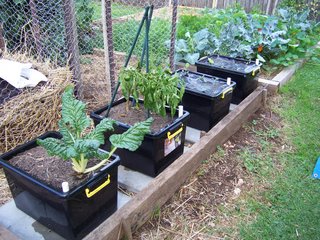
For quick, easy and cheap you might want to try a few veggie boxes based on polystyrene foam veggie containers or even some broccoli box wicking beds although if you want to move them you will need to get the water out of them first......because they are bloody heavy when full.
Herbs grow easily and well in containers and a few herbs go a long way, some basil, rosemary and parsley in pots will give your home grown meals a bit of flair and if you have some more space and want to go Asian some coriander and lemongrass will work well too. Friends of ours have talked about making a portable herb spiral out of rocks and potted herbs so that is something to think about as well.
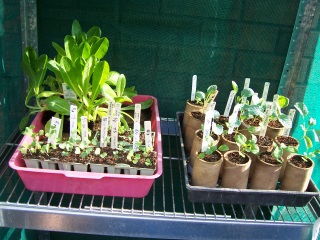
There are small and easily relocatable greenhouses available these days so if you want to you can raise your own seedlings from scratch with a minimum of effort, and save yourself heaps of cash in the process. With some worm castings or compost (see waste, below) you can even have a go at making your own potting/seed raising mix and be even more in control of your food supply.
With very little or no outside room you can still grow sprouts and microgreens. Microgreens will need some sunlight and if you can make a place for some in your small greenhouse so much the better. Sprouting using the glass jar method is easy and cheap to set up, but if you want home produced sprouts to be a major part of your diet consider making a seven day sprouter, which will easily keep a family of four in sprouts almost continuously.
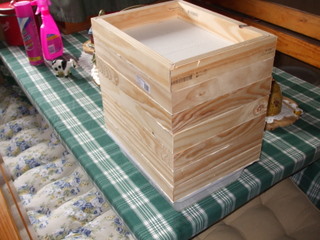
Fruit is a little more difficult but you can keep many kinds of dwarf fruit trees (citrus, apples, stone fruit) in large pots, a house just isn’t a home without at least one lemon tree. It might be worth trying to grow them in self watering containers based on 20 litre buckets.
Water
Water capture and storage
Unless there are already water tanks at the rental property this one can be a bit difficult but there are a number of ways to divert rainwater for storage and use without altering the property permanently. One ways is just to cut into a (hopefully plastic) downpipe and then put a conventional 60 litre garbage bin, wheelie bin or plastic open head 200litre drum underneath the cut end to store your water in. There are a number of purpose built contraptions like a wheelie bin with a pump in the bottom of it to help you make use of harvested rainwater but the most cost effective way would be to set up a food grade open head 200litre plastic drum with a tap in the bottom and a hose connected to it.
If you can get permission and want to store more water you might want to consider putting in one of those corrugated steel walled, plastic lined swimming pools but if you don’t want the precious water to go green you will need to contrive an opaque plastic cover to keep the light out. Then to use the water just siphon it out with a garden hose onto the veggies beds for free watering.
Of course you will need to set up the downpipe to run through to stormwater again before you leave the property and it would probably be best not to cut into the most obvious downpipe next to the front door!
Greywater
The easiest way to use greywater is to slap a hose on the end of your washing machine output and then divert it to trees or lawn or perhaps even veggies if the output is under your mulch layer. Use the most natural biodegradable detergent or soap that you can and be aware that even soap contains sodium which can build up in your soil over time, so not too much in one place.
Needless to say you should always catch the first part of your cold shower water before it starts to run hot in a bucket and then put it on the veggies, but you might also consider showering in one of the larger plastic tubs (you know, the flexible ones with handles?) and then dump the shower water outside. If your bathroom is in the right area and your shower over the bath you could put the plug in and once everyone has had their shower use you faithful garden hose again to siphon it outside onto the garden. It took a lot of energy to purify that water and get it to you so make it do double duty if you can!
Reducing water use
Of course the best way to use water sustainably is to not use it at all and the first step to cutting down on your water use is to understand where it is going. Even if it is not your place and you can’t go through all of the steps do a water audit. It will give you an idea of where your highest areas of water usage and following on from that may be some ideas on how you can reduce it. Here a few suggestions –
- If your toilet is an old single flush type, stick a brick or full 2 litre water bottle in to reduce the volume of each flush. If it is a newer dual flush/low flush toilet don’t try this trick it might reduce the volume too much.
- While we are on the subject of toilets – if it’s yellow let it mellow; if it’s brown flush it down!
- Fix any leaking taps or toilet leaks immediately
- Install a water efficient shower head, you can even take it with you when you leave.
- Take shorter showers – if you really want to be hard core, rinse yourself down, turn the shower off and soap up then rinse again. Otherwise see if you can keep your showers down to 3 or 4 minutes.
- Fit aerators to all taps (mmmm, maybe check with the landlord first....)
- Scrape dishes clean rather than rinsing where you can. I have heard of people pushing plates into a bucket of dry sand to remove food residue.
-
If you are buying a major water using appliance like washing machine or dish washer, go for the most water efficient one you can afford.
Energy
It doesn’t make much sense to spend thousands of dollars on a grid connected array of solar panels, that you will then have to leave when you move, but there is still a lot you can do on the energy front to live more sustainably. If you are a bit of a tech head you could put together a portable photovoltaic array complete with batteries and 12 volt appliances or even an inverter, but that is somewhat beyond the scope of this article.
Probably the most important thing is to change your electricity supplier over to a green power option if you are able, but there are also lots of things you can do to reduce your energy use.
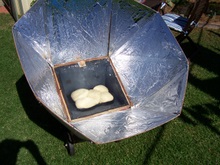
- Like with the water-using appliances make sure that you buy the ones with the most stars and the least consumption, including bypassing a plasma TV for an LED or LCD screen.
- Turn off lights when not in use, change to compact fluoros and open the blinds and curtains to let the sunshine in during the day.
- Heating and cooling takes extra energy so put on a jumper instead of the heater and make sure the seal on your fridge is good. Don’t put hot foods directly in the fridge either, let it cool down first.
- Tool up for low energy cooking by making a stored heat or haybox cooker, making your own solar oven and getting hold of a pressure cooker. A wok is good to have too; the quick high heat cooking in a wok is good for preserving nutrients as well as saving energy.
- Wash your clothes, hands and clean your teeth with cold water. You can have lots of hot drinks during the day by boiling up the kettle or jug once in the morning and putting the hot water into a thermos for use later.
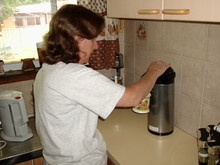
Waste
Most urban areas have a good recycling system so if your local council has one, make us of it fully but don’t forget to avoid packaging, especially food packaging because there is so much of it, whenever you can. For your food waste, veggie peelings and other putrescible waste you can put it in a composter if you have room for one or make yourself a worm farm and keep the worms happy. Another option for those without a lot of room is to make yourself a bokashi bucket and then use the output for your worms or directly dig it in to where you intend to grow veggies. See if there is a local food co-op so you can buy what you don’t grow, but still keep your packaging waste as low as possible.
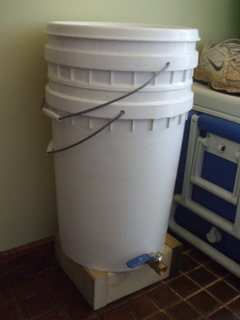
Even in rented accommodation you can find ways to have a smaller footprint so have a think about what you can do. Starting small is a good thing to do, but the main thing to do is to start!



